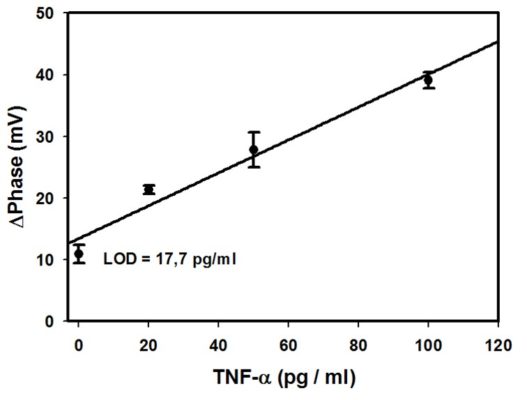Development of an inmunoassay based on high resolution acoustic sensors for the detection of TNF-alpha.
Clinical diagnosis and customized future medicine requires new methodologies and instruments for reducing costs and detection time. In this project, a piezoelectric inmunosensor for the detection of TNF-alpha biomarker has been validated. This biomarker is involved in the pathogenesis of inflammatory diseases and neurodegenerative diseases at ocular and extra-ocular levels. In particular, in ophthalmological pathologies, such as glaucoma, it has been observed that levels of this biomarker increase, which seems to strengthen levels of neurodegeneration. TNF-alpha levels differs from one patient to another. Therefore, to determine the level of each patient, in order to administer a specific treatment or to follow a specific therapy, increases the pharmacological efficacy and avoids possible adverse reactions. The technique currently used for the detection of this biomarker is the enzyme immunoassay (ELISA- Enzyme Linked immunosorbent Assay). The advantages of ELISA are its simplicity, speed, low cost and high sensitivity and selectivity. Immunoassays are capable of specifically detect a target analyte in a complex sample, and are based on the interaction of an antigen (analyte) with an antibody that specifically recognizes it. In ELISA technique, the detection of the analyte is always indirect, because one of the immunoreactive is labeled. Labeling may compromise the biochemical reaction, being this its main disadvantage. The test time is another disadvantage of ELISA. An alternative to ELISA is provided by piezoelectric immunosensors. This technology shares the advantages of ELISA, and solves its main disadvantages. In a piezoelectric immunosensor, one of the immunoreactives is immobilized on the surface of an acoustic transducer, and a direct physical signal is generated when the interaction takes place. This feature allows a label free and real-time detection. The transducer used is a High Fundamental Frequency Quartz Crystal (HFF-QCM). The project has demonstrated, through a proof of concept, that piezoelectric immunosensors can be a promising technology for the detection of TNF-alpha concentration.
The main objective of the project was to explore 3 innovative features of the HFF-QCM technology versus the currently used reference technique (ELISA): assay time, assay cost and Limit Of Detection (LOD). The results have been the following:
1) Assay cost is higher than that of ELISA, because the proposed assay format(sandwich) consumes more immunoreactive. This could be solved by using gold nanoparticles whose cost is lower than that of the immunoreactive ones.
2) Assay time (including sensor regeneration) is approximately 25 minutes, while in ELISA it is 5 hours. Additionally, multianalyte capacity remains, being a challenge not achieved yet by immunosensors technology.
3) LOD is of the same order as that obtained with ELISA and it could be improved by using gold nanoparticles.


